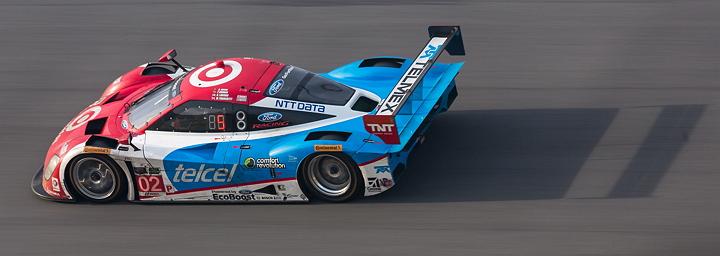
The Ford EcoBoost engine that powered this car featured a 3D printed intake setup which led drivers Scott Dixon, Kyle Larson, Jamie McMurray and Tony Kanaan to victory in the brutal 24 Hours of Daytona
The 24 Hours of Daytona is the sports car endurance race held annually at Daytona International Speedway in Florida. Run on a 3.56-mile-long road course, it’s the first major automobile race of the year in the United States. It’s one leg of the what’s known as the Triple Crown of endurance racing, along with Sebring and Le Mans, and the race combines the skills of a group of drivers tasked with piloting their specialized cars for a full day to the finish line.
It’s a brutal test of both man and machine which requires rock solid, reliable performance in the crucible of racing.
While Ford uses several 3D printing labs to rapidly prototype parts for street cars making everything from buttons and knobs to intakes and engine covers, the company’s use of 3D printing isn’t limited to street-legal cars. It was also used for high-performance racing machines, and Ford won the 24 Hours of Daytona 2015 using one of those thoroughbred vehicles which featured a 3D printed intake manifold.
“We have the ability to design an entirely new part and, one week later, have that part in hand. This lets the engineers who develop our cars – both for road and track – spend more time testing, tuning and refining,” says Victor Martinez, a race engine engineer on the 3.5-liter EcoBoost project which took the title.
Parts such as the intake manifold on the Ford EcoBoost race engine have proved essential to the process of developing high-performance engine systems.
“3D computer printers have totally changed the development process for our Daytona Prototype race cars,” says Martinez. “3D printing has advanced at such lightning speed in recent years that, in a matter of hours, we can create real, usable parts for race cars. That’s exactly what we did for the 24 Hours of Daytona earlier this year.”
Ford product development first began using 3D printing decades ago and in fact, the company purchased what they say was the third 3D printer ever made back in 1988.
But from those humble beginnings when the company used the devices for prototyping buttons and knobs, the technology is now capable of such precision that the 3D printed parts are used in real-world applications like the Ford race car that won the 53rd running of the grueling Daytona race.
“We have the ability to design an entirely new part and, one week later, have that part in hand,” Martinez says. “This lets the engineers who develop our cars – both for road and track – spend more time testing, tuning and refining.”
Martinez says that toward the end 2014, Ford Performance began to design revisions for an intake manifold, and it led them to 3D print several intakes and test them. The result was the most advanced intake yet printed, and in combination with carbon fiber intake plenums developed by Multimatic, the manifold was used for the No. 02 Target Ford EcoBoost-Riley race car.
“The prototype manifold exceeded our expectations in testing, so in the essence of time we decided to use it for the race,” said Martinez. “We modified our intake with carbon fiber components, painted it, and then it was ready to go to the track.”
And it worked like a charm as Chip Ganassi Racing, with drivers Scott Dixon, Kyle Larson, Jamie McMurray, and Tony Kanaan at the wheel, won the Daytona classic by holding off serious competitive threats through the final hour of the race.
Do you know of any other motor racing applications of 3D printing? Let us know in the 3D Printed Racing Parts forum thread on 3DPB.com.
Subscribe to Our Email Newsletter
Stay up-to-date on all the latest news from the 3D printing industry and receive information and offers from third party vendors.
You May Also Like
Further Understanding of 3D Printing Design at ADDITIV Design World
ADDITIV is back once again! This time, the virtual platform for additive manufacturing will be holding the first-ever edition of ADDITIV Design World on May 23rd from 9:00 AM –...
3D Printer Maker EVO-tech Reborn as NEVO3D — Once More With Feeling
EVO-tech was a 3D printing service and original equipment manufacturer established in 2013 and based in Schörfling am Attersee, Austria. The company produced high-quality material extrusion systems featuring linear bearings,...
3D Systems Brings 3D Printed PEEK Cranial Implant to the U.S. with FDA Clearance
For more than 10 years, 3D Systems (NYSE:DDD) has worked hand-in-hand with surgeons to plan over 150,000 patient-specific cases, and develop more than two million instruments and implants from its...
CDFAM Returns to Berlin for Second Annual Symposium
The second CDFAM Computational Design Symposium is scheduled for May 7-8, 2024, in Berlin, and will convene leading experts in computational design across all scales. Building upon the first event...
































